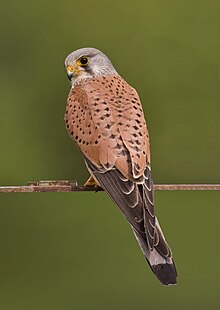| Eufalconimorphae | |
|---|---|

| |
| Common kestrel, Falco tinnunculus | |
| Scientific classification | |
| Domain: | Eukaryota |
| Kingdom: | Animalia |
| Phylum: | Chordata |
| Class: | Aves |
| Clade: | Australaves |
| Clade: | Eufalconimorphae Suh et al., 2011 |
| Subclades | |
Eufalconimorphae is a proposed clade of birds, consisting of passerines, parrots, falcons, caracaras, and forest falcons (but not other raptors).[3] It has whole-genome DNA support.[4] This clade was defined in the PhyloCode by George Sangster and colleagues in 2022 as "the least inclusive crown clade containing Falco subbuteo and Passer domesticus".[5] Eufalconimorphae birds are characterized by their strong and hooked beaks, sharp talons, and powerful wings. They have excellent eyesight, which allows them to spot their prey from great distances. The Eufalconimorphae is noted to produce aerodynamic force during the upstroke of flight to help create a vertical flight pattern.[6]
See below cladogram showing Eufalconimorphae's relationship within Australaves:[4][7]
| Australaves |
| ||||||||||||||||||
- ^ Boles, Walter E. (1997). "Fossil songbirds (Passeriformes) from the Early Eocene of Australia". Emu. 97 (1): 43–50. Bibcode:1997EmuAO..97...43B. doi:10.1071/MU97004.
- ^ Kuhl., H.; Frankl-Vilches, C.; Bakker, A.; Mayr, G.; Nikolaus, G.; Boerno, S. T.; Klages, S.; Timmermann, B.; Gahr, M. (2020). "An unbiased molecular approach using 3'UTRs resolves the avian family-level tree of life". Molecular Biology and Evolution. 38: 108–127. doi:10.1093/molbev/msaa191. PMC 7783168. PMID 32781465.
- ^ Alexander Suh; Martin Paus; Martin Kiefmann; Gennady Churakov; Franziska Anni Franke; Jürgen Brosius; Jan Ole Kriegs; Jürgen Schmitz (2011). "Mesozoic retroposons reveal parrots as the closest living relatives of passerine birds". Nature Communications. 2 (8): 443. Bibcode:2011NatCo...2..443S. doi:10.1038/ncomms1448. PMC 3265382. PMID 21863010.
- ^ a b Jarvis, E. D.; Mirarab, S.; Aberer, A. J.; Li, B.; Houde, P.; Li, C.; Ho, S. Y. W.; Faircloth, B. C.; Nabholz, B.; Howard, J. T.; Suh, A.; Weber, C. C.; Da Fonseca, R. R.; Li, J.; Zhang, F.; Li, H.; Zhou, L.; Narula, N.; Liu, L.; Ganapathy, G.; Boussau, B.; Bayzid, M. S.; Zavidovych, V.; Subramanian, S.; Gabaldon, T.; Capella-Gutierrez, S.; Huerta-Cepas, J.; Rekepalli, B.; Munch, K.; et al. (2014). "Whole-genome analyses resolve early branches in the tree of life of modern birds" (PDF). Science. 346 (6215): 1320–1331. Bibcode:2014Sci...346.1320J. doi:10.1126/science.1253451. hdl:10072/67425. PMC 4405904. PMID 25504713. Archived from the original (PDF) on 2015-02-24. Retrieved 2015-08-29.
- ^ Sangster, George; Braun, Edward L.; Johansson, Ulf S.; Kimball, Rebecca T.; Mayr, Gerald; Suh, Alexander (2022-01-01). "Phylogenetic definitions for 25 higher-level clade names of birds" (PDF). Avian Research. 13: 100027. Bibcode:2022AvRes..1300027S. doi:10.1016/j.avrs.2022.100027. ISSN 2053-7166.
- ^ Razmadze, Daria; Panyutina, Aleksandra A.; Zelenkov, Nikita V. (October 2018). "Anatomy of the forelimb musculature and ligaments of Psittacus erithacus (Aves: Psittaciformes)". Journal of Anatomy. 233 (4): 496–530. doi:10.1111/joa.12861. PMC 6131962. PMID 30033585.
- ^ Kuhl H, Frankl-Vilches C, Bakker A, Mayr G, Nikolaus G, Boerno ST, Klages S, Timmermann B, Gahr H (January 2021). "An unbiased molecular approach using 3'UTRs resolves the avian family-level tree of life". Molecular Biology and Evolution. 38 (1): 108–127. doi:10.1093/molbev/msaa191. PMC 7783168. PMID 32781465.
